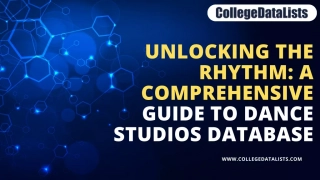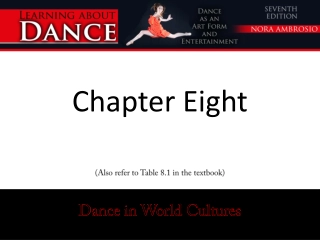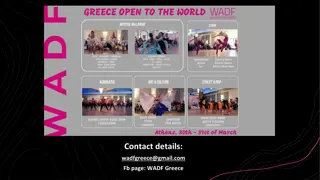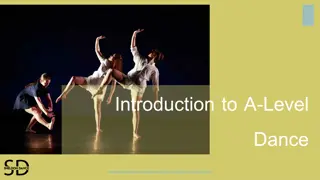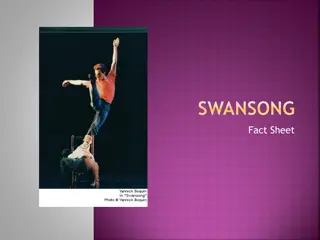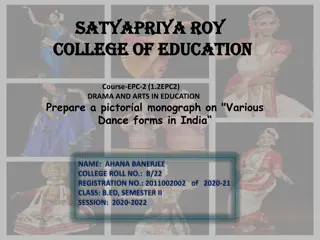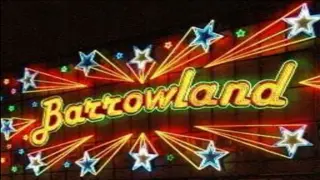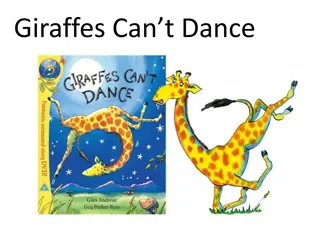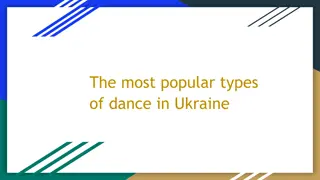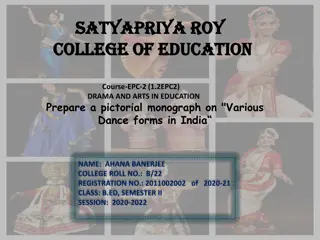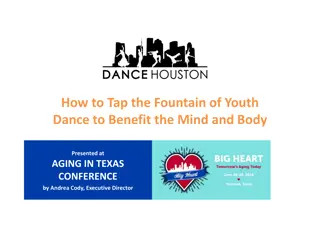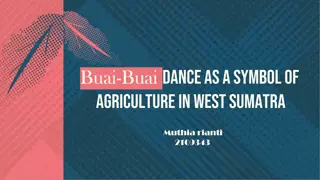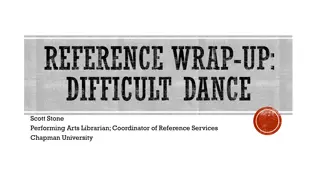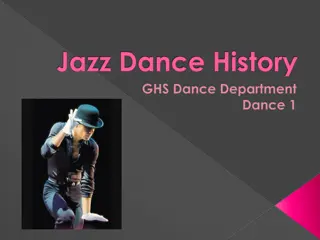Exploring the Rich Dance Forms of India
India's diverse cultural landscape is reflected through its various dance forms. From the spiritual Classical dances to the celebratory Folk dances, each form carries a unique essence and history. Bharatnatyam, Kathak, Kuchipudi, and more showcase the vibrant traditions and stories of different regions. Discover the beauty and significance of Indian classical dances through this pictorial monograph.
Download Presentation

Please find below an Image/Link to download the presentation.
The content on the website is provided AS IS for your information and personal use only. It may not be sold, licensed, or shared on other websites without obtaining consent from the author.If you encounter any issues during the download, it is possible that the publisher has removed the file from their server.
You are allowed to download the files provided on this website for personal or commercial use, subject to the condition that they are used lawfully. All files are the property of their respective owners.
The content on the website is provided AS IS for your information and personal use only. It may not be sold, licensed, or shared on other websites without obtaining consent from the author.
E N D
Presentation Transcript
Name Sumita Shaw Roll No-B/5 College Satyapriya Roy College of Education Course- EPC-2 Practicum- Prepare a Pictorial Monograph on Various Dance Forms in India .
Dance in Indian Land India is a land of diversities. Various climatic conditions have made India a diverse country. In all spheres of Indian life diversities are clearly visible. These diversities have made the Indian culture a unique one. Like all other aspects of life, the dance forms of India are also varied and different. There are many types of dance forms in India, from those which are deeply religious in content to those which are performed on small occasions The Classical dances of India are usually spiritual in content. Though the folk dances of India are also spiritual and religious in content but the main force behind the folk dances of India is the celebratory mood. Dances are a form of coherent expression of human feelings. Like the Indian culture, Indian classical dances are equally diverse in nature. Each dance form can be traced to different parts of the country. Each form represents the culture and ethos of a particular region or a group of people.
Bharatnatyam (Dasi Attam) Kuchipudi (Brahmin story telling) Kathakali (half-Aryan and half-Dravidian) Kathak ('katha' meaning story) Manipuri (Gandharvas and the Goddess of Dawn) Odissi (temples and religion) History of Indian classical dances
SOME CLASSICAL SOME CLASSICAL DANCE DANCE FORMS FORMS: : Bharatnatyam Dance Native to Tamil Nadu (a state in Southern India). Bharatanatyam is one of the popular Indian classical dance forms previously referred to as Sade, Dasiattam and Thanjavut Natyam demands unconditional and complete dedication from the performer. The dynamic and earthy style of this dance makes it one of the most chosen forms of Indian classical dance. Although Bharatanatyam is predominantly performed by women, men are also known to engage in it. While the women wear a typical sari in the dance performance, men have bare chest and wear a dhoti outfit in the lower part of the body. Eminent Personalities in the field of Bharatanatyam : 1. Rukmini Devi 2. Padma Subrahmanyam 3. Alarmel Valli
Kathak Dance Kathak, northern India, represents one of the eight forms of Indian classical dances. The name Kathak has been derived from the Sanskrit word katha', meaning 'katthaka' means the one who tells a story. Kathak focuses more on the footwork of the dancer. which originated in story. Thus, Eminent Personalities: 1. Pandit Birju Maharaj 2. Shambhu Maharaj
Kuchipudi Dance Kuchipudi was introduced as a dance drama, but its present day dispensation tells a different story altogether. It has now been reduced only to dance form, with the drama missing completely. With proficient training and knowledge, Kuchipudi dancers presenting the dance form in their individualistic ways, today. In the present times, majority of the Kuchipudi dancers are women. Eminent Personalities: 1. Mallika Sarabhai. 2. V. Satyanarayana Sarma the have started
Manipuri Dance Manipuri is the classical dance from the Manipur region in the North East. Very much religious and associated to Vaishnav cult of Hinduism, the art form primarily depicts episodes from the life of Lord Vishnu. Manipuri dance style is multifaceted and ranges from the softest feminine masculine. Dignified grace is found in every aspect and the range it offers in technique, rhythm and tempo which makes a Manipuri an absorbing and exhilarating experience. to the vigorous Eminent Personalities: 1. Yumlembam Gambhini Devi. 2. Guru Bipin Sinha.
Mohiniattyam Dance Mohiniattyam, in literal terms means Mohini's dance. Mohini, according to Indias mythology, is a very beautiful woman, who attracts people instantly. She is regarded as an enchantress and thus, Mohiniattyam is the dance of the enchantress. It is believed to have. been named after Lord Vishnu, who had disguised himself as "Mohini with an intention to slay Bhasmasura and during the churning of nectar from the ocean as well. However, the basis of this dance is not seduction transformation of Lord Vishnu into a female form and also the concept of 'Ardhnareeshwara male and female as one. Like many other dance forms, it is essentially dedicated to the love and devotion towards God and was restricted to the Devadasis. Eminent Personalities: 1. Krishna Panicker 2. Kalamandalam Kalyanikutty Amma alone. It also signifies
Odissi Dance Based on Natya Shastra. Odissi is regarded as one of the oldest surviving dance forms of archaeological evidence. It has originated from Orissa and its history can be traced back to the 2nd century BC. The dance form has been extensively depicted in the sculptures of Brahmeswara temple and Sun Temple at Konark Kelucharan Mohapatra, an erstwhile Goti Pua, is the greatest exponent and guru of Odissi. Some of the other exponents of this dance form are Indrani Rehman, Sonal Mansingh, Sanjukta Panigrahi, Protima Gauri Bedi, Madhavi Mudgal, Guru Mayathirai. Guru Deva Prasad Das and Guru Durga Charan Das. Eminent Personalities: 1. Geeta Mahalik. 2. Sonal Mansingh. India, with well preserved
FOLK DANCES OF CENTRAL INDIA Folk dance can be defined in the simplest words as a form of dance, developed by a group of people, which reflects the traditional life of the people of a certain country or region. This form of dancing involves a group of happy people, following dance instructions given by an experienced caller. The steps are performed in certain formations, such as a circle or a straight line, by the dancers. The term folk dance is reserved and is mainly kept for dances which are, to a major degree bound, by tradition. However, with time, these dances have laid down the foundation for a number of modern dances. The multi-cultural country of India has also seen the development as well as growth of folk dances till date. The name of some of the popular folk dances of central India are as follows- Gaur Dance Muria Dances Saila Dance Karma Dance Kaksar Dance
Folk Dances of North Eastern India India has a rich and varied collection of folk dances. In fact, these dances form a very important part of the life of most Indians, in terms of entertainment and celebration, particularly those living in the rural areas. India folk dances are originated from the ordinary people of a society or region and today, serve to reflect the diversity in the country s tradition and culture. There are so many folk dances found in different states of India that trying count their number seems to be a Herculean task. So, here we are mentioning some of the popular folk dances of North East India which are as follows:- Naga Dances (Naga land) Bihu (Assam) Hajgiri (Tripura) Thang-ta & Dhol-Cholom (Manipur) Nongkrem (Meghalaya) Folk Dance of Arunachal Pradesh Folk Dances of Sikkim
Folk Dances of South India Folk Dances in India have made great contribution in the development of the classical dance forms of the country. They are less complex in technique, than their Classical counterparts, but do follow a broad set of rules, which vary from one dance to another. Folk dances serve as an important part of the life of many Indians, as entertainment options, particularly those who live in the rural areas. There are so many folk dances and their variations that can be found in India that trying to count their number is almost impossible. However, we can broadly divide them into seven regions, namely Central India, Eastern India, North East India, Northern India, North West India, South India and South West India. In this section, we would acquaint ourselves with the popular folk dances of South India Like:- Padayani or Paddeni (Kerala) Kummi and Kolattam (Tamil Nadu) Kargam and Puli Vesham (Tamil Nadu)
Dance has traditionally been an important part of religion and culture in India. According to Indian legend, invented dance. Dancing is one of the most revered Hindu arts be cause it melody, drama, form and line. Gestures, body positions and head movements emphasized in Indian dance. the gods Conclusion incorporates are
References 1) Six classical Dances of India. Retrieved from https://Britannica.com 2) An Introduction to India s Classical Dance Forms. Retrieved from https://theculturetrip.com 3) A walk through India: the famous classical Indian dance forms and their state of origin. Retrieved from https://timesofindia.indiatimes.com 4) Dance Forms. Retrieved from https://www.incredibleindia.org 5) http://dances.iloveindia.com/dance-elements 6) https://www.youtube.com/


